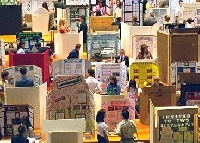
Science fair presentation tips to make sure your contest entry shines
It’s science fair season! Time to gather test tubes and robotic parts, thermometers and display boards. And time to hope that your science fair project earns the blue ribbon.
But did you know that when it comes to earning awards, how your project looks can be almost as important as the type of experiment you do? That’s why I’ve gathered these science fair presentation tips to help you present your project in the best way possible.
Visual appeal
The way your project board and display table look really does matter. Consider things like:
Color
Make sure the your display includes color to highlight your pictures, reports, titles and any pieces of your experimental equipment you’re including at the fair itself. A display that lacks color or one that includes too many colors are both less likely to win than one with a cohesive color theme.
~
Also, make sure the colors you choose for your display board, paper and other elements don’t clash with your project, especially if color is important to your results. For instance, if your science fair project included growing colorful crystals, make sure the paper on which you display provides good contrast, and allows judges and visitors to really see what you’ve done.
Arrangement
Make sure the various pieces of your display are arranged for easy viewing. If people have to look behind things, move things or cannot tell why elements are included, you could lose points … or even the science fair.
Make it easy for viewers to see what goes where, and how the content progresses through your display for maximum impact.
Fonts
Make sure the fonts and type styles you choose for your science fair display are clear and large enough for people to easily read.
Opt for simple fonts, with one for titles and another for content to keep it clear. Save the cursive and fancy fonts for art projects.
Pictures
Photos and drawings are a great way to share the experimental process with your viewers. Consider including photos showing each stage, from set up to conclusion, especially if your experiment doesn’t allow viewers to see the results in person.
Height
Make sure your display board and other elements are high enough for the average viewer to see easily. If necessary, use boxes to raise certain elements or to emphasize the most important parts.
Information
One of the most important science fair presentation tips concerns the content you share. When you’re preparing your reports for the science fair, make sure you’ve clearly stated:
- The reason you were interested in this subject
- All of the scientific method elements (hypothesis,experiments, etc.)
- A summary of your conclusions, as well is the more detailed item by item results
- A discussion of any Issues or problems you had with the experiment, the scientific tools you used, any questions that remain unanswered
Interaction
If at all possible, providing viewers with a way to interact with your science fair project exhibit. Allow them to touch something, try a process (like a toy car on an inclined plane), smell something (just make sure it’s non-toxic!), or hear a sound you were investigating (like the music you played for plants.)
By drawing them into the experimental process or the results, you may well improve their impression of your work.
